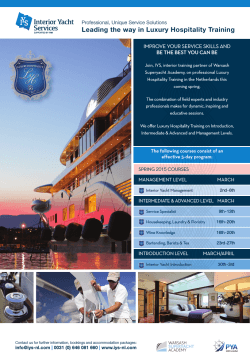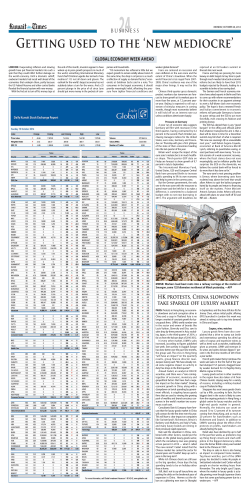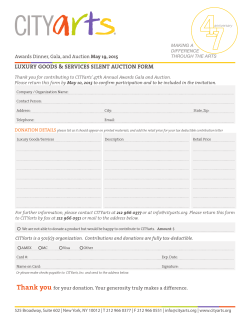
here - Martini Media
THE MARTINI REPORT The Affluent Audience Online Vol 2: Luxury Goods winter 2015 MARTINIMEDIAINC.COM THE MARTINI REPORT | VOLUME 2: LUXURY GOODS THE MARTINI REPORT: AN IN-DEPTH PERSPECTIVE ON LUXURY Luxury expresses personal values, communicates social status, embodies artistic sensibilities, and makes one feel beautiful. Luxury is, in essence, about passion. Passion inspires great art, great craftsmanship, and—among those who can afford it—great spending. Even today, as much of the global economy struggles to gain momentum from economic turmoil that began eight years ago, the luxury market remains strong and continues to grow. Companies that might be considered to be “exclusively” in the luxury business generate more than $300 billion annually in revenue, and when one includes luxury offerings from categories such as automotive and travel, the size of the luxury market easily exceeds $1 trillion. And while many sectors of the global economy have struggled since the Great Recession, luxury sales have grown steadily every year since. Luxury sales growth has gone hand-in-hand with strong profit margins, which are 60 – 70% or greater for many elite luxury brands. The unique nature of luxury brings unique challenges for marketers. It is by definition discretionary and non-essential. Its appeal is emotional and aspirational, but as we shall see, the process of purchasing luxury is increasingly careful, considered, and heavily-researched. Luxury’s most important benefits are often intangible, but it is purchased with very tangible dollars. Buying and experiencing luxury is a combination of right-brain and left-brain considerations found in very few other marketplaces. This White Paper offers a road map to navigating these challenges by synthesizing data from a variety of sources, the most important of which is new custom research conducted specifically for Martini Media. More information about the research methodology, along with definitions of key segments, can be found on the final page. We start by exploring yet another of luxury’s challenges— the fact that luxury is multi-dimensional, multi-faceted, and continually evolving. The total size of the luxury market exceeds $1 trillion, and has grown steadily since 2008… 1 Key Segments: The Martini Report explores the online behavior of four key segments of the Affluent market, defined below based on annual household income and age. The Hyper Affluent are the 3% of Americans with at least $250,000 in annual household income The Mass Affluent have household income in the $100K – 249K range, and represent about one-fourth of the US population. The Emerging Affluent have household income in the $75K – 99K range, and are ages 18 – 39— these young up-and-comers share many media and spending habits with the Hyper Affluent. The Aspiring Affluent have household income in the same $75K – 99K range as the Emerging Affluent, but are over the age of 40, and many have likely plateaued in their earning potential. MARTINI REPORT AFFLUENCE SEGMENTS THE MARTINI REPORT | VOLUME 2: LUXURY GOODS DEFINING THE AFFLUENT 2 The first Martini Report detailed a litany of factors that collectively suggest bright prospects for Affluentfocused media and marketers, including the growing size, spending power, and economic comfort of the Affluent market. This second Martini report extends these findings with a specific focus on luxury growth among those already in the market, and finds substantial numbers expressing growing luxury interest. Among those who made a luxury purchase in the past year, about four-in-ten Hyper Affluents express growing signs of luxury interest, a sentiment particularly strong among younger Affluents. I AM MORE INTERESTED IN BUYING LUXURY PRODUCTS AND SERVICES THAN I WAS JUST A FEW MONTHS AGO 47% $100K+ HHI AGE 18 —39 28% MASS AFFLUENTS THE MARTINI REPORT | VOLUME 2: LUXURY GOODS LOOKING AHEAD: SOLID PROSPECTS FOR LUXURY GROWTH 40% HYPER AFFLUENTS I WILL PROBABLY BUY MORE LUXURY ITEMS NEXT YEAR THAN I DID THIS YEAR 57% $100K+ HHI AGE 18 —39 33% MASS AFFLUENTS 42% HYPER AFFLUENTS Base: Among those who made a luxury purchase in the past year 3 Luxury is a reflection of consumer emotions, aspirations, and passions —as such, it is not static, and it continually evolves as consumer mindsets evolve. Consider that nearly two-thirds of Hyper Affluents agree, “The definition of luxury is not the same as it was five years ago” —the up-and-coming segment of Emerging Affluents is even more likely to agree with this sentiment. The luxury boom of 2004-2007 was marked by a shared sense of what luxury meant —the imagery of yachts, private jets, and elegant apparel were pervasive, and classic luxury brands thrived as a result. Mass Affluent (and even upper middle class) consumers felt wealthier than they actually were, and spent accordingly; many luxury brands responded with lowerpriced accessories to reach this growing market defined by “aspirational luxury shopping.” With the recession, luxury evolved, becoming more idiosyncratic, intimate and personally-meaningful. It became less about the logo and more about what the logo meant to the individual. Luxury also became more subtle and understated, and value became a key theme. Mobile devices became the new “mass” luxury, and morphed luxury expectations more generally, particularly regarding minimalist design and practical utility. In a very real sense, Affluent passions have shifted— from ownership and status to experiences and intrinsic satisfaction. WHAT LUXURY MEANS TO HYPER AFFLUENTS RISING THE MARTINI REPORT | VOLUME 2: LUXURY GOODS AFFLUENT ATTITUDES & THE EVOLUTION OF LUXURY Source: Ipsos Media CT FALLING % ASSOCIATED EACH TERM WITH “LUXURY” With new passions come a new language of luxury, and a new set of priorities. Quality is paramount. A good reputation and strong user reviews are key decision factors. There is no longer the expectation that luxury has to be expensive —it can be accessible and inexpensive (as the growth of luxury “flash sale” sites have shown). Luxury brands that have positioned themselves as “exclusive” or “status-oriented” have increasingly found themselves swimming upstream against these consumer trends —those same products and experiences can often be more effectively positioned as “unique” or “rare,” assuming they can make those claims authentically. The bottom line: Marketers must stay abreast of Affluent trends to keep hitting the right hot buttons, and resonate with today’s emotional sensibilities. 63% of Hyper Affluents who purchased luxury in the past year agree, “The definition of luxury is not the same as it was five years ago.” 4 Luxury is about passion, and it is being reshaped by two other emerging Affluent passions — technology, and the desire to make smart purchase decisions. Technology is infusing into the DNA of luxury, with today’s elegantly-designed yet practical technological devices becoming the new “aspirational” luxury purchase (particularly for “marginally” Affluent segments), and reshaping how consumers think about luxury more broadly. While many of the luxury purchases of the 2004-2007 boom were relatively spontaneous, today’s pervasive value-orientation inspires thoughtful, carefully-considered, heavily-researched purchases. This is true across the income spectrum, including the Hyper Affluent, and across the price/quality spectrum, including luxury and mainstream offerings alike. For example… •Among Hyper Affluents who purchased luxury in the past year, more than one-third always research luxury products online before purchasing, and another half do so sometimes —Emerging and Mass Affluent are even more likely to say “always.” 83% of Hyper Affluents always or sometimes do online research prior to making luxury purchase* If I can’t decide which luxury item to buy, I’ll usually go with the item that has.. •In the past 60 days alone, substantial numbers of Hyper Affluents researched luxury products/services via computer (58%), smartphone (46%), or tablet (45%) —figures that rise significantly among Emerging Affluents (computer 96%, smartphone 88%, tablet 75%). THE MARTINI REPORT | VOLUME 2: LUXURY GOODS CONVERGING PASSIONS: LUXURY, TECHNOLOGY, & SMART DECISIONS The importance of research by Affluents is underscored by the factors that underlie many luxury purchases. When undecided about a luxury purchase, quality is the most widely cited tiebreaking factor, followed by price and (particularly among women) consumer reviews —all factors that involve research. The easier and more intuitive factor of a recognized brand name is cited by few as the final motivating factor. RESEARCHING PRODUCTS, SERVICES OR PRICES ON THE INTERNET IN PAST WEEK RESEARCHING LUXURY PRODUCTS OR PRICES ON THE INTERNET IN THE PAST 60 DAYS 5 THE MARTINI REPORT | VOLUME 2: LUXURY GOODS DIGITAL MEDIA IS THE TOP INFLUENCE ON LUXURY PURCHASES As an influence on luxury purchases, digital media have the widest impact across virtually every segment, out-pacing magazines, newspapers, radio, personal recommendations, and advice from retail sales associates. It is worth noting that across the half-dozen categories for which we have asked similar questions, recommendations from family and friends almost always top the list of influences, making the top ranking of digital media here particularly remarkable. This may reflect the personal nature of many luxury purchases—people innately understand their own emotional yearnings, and some luxury purchases are aspired to for years before the transaction takes place, limiting the need for suggestions from others. Digital media tops the list of luxury influences, out-pacing even recommendations from family and friends, which tops the list in most categories SOURCES MOST RELIED ON FOR IDEAS, INSPIRATION, AND RESEARCH ABOUT LUXURY GOODS 75% 63% 30% 53% 21% 49% 17% 45% 51% 45% 18% EMERGING 48% 50% 35% 31% 15% 13% MASS 18% 10% 26% 6% HYPER Base: among the two-thirds who cite some media influence on their luxury purchases 6 Within the broad category of digital media, the brand’s website and consumer reviews are by far the most influential and trusted sources when researching luxury online. Online advertising and luxury-oriented sites constitute the next tier of drivers, generally ranking ahead of blogs or websites published by magazines. While brand websites and customer reviews are the most important across age groups, more subtle generational differences do emerge for other influences, with blogs being more important among younger Affluents, and advertising more important among Affluents over age 40. This underscores the importance of fine-tuning media allocations based on target demographics. MOST TRUSTED SOURCES FOR LUXURY PRODUCT INFORMATION 100 0 BRAND WEBSITE CUSTOMER REVIEWS ASPIRING ADVERTISING LUXURY WEBSITES EMERGING MASS MAGAZINE WEBSITES THE MARTINI REPORT | VOLUME 2: LUXURY GOODS BRANDS’ WEBSITES AND CUSTOMER REVIEWS ARE TRUSTED BY LUXURY SHOPPERS BLOGS HYPER THE PASSION FOR ONLINE SHOPPING EXTENDS TO LUXURY OFFERINGS While digital media use is pervasive in the process of researching luxury products and services, actually making luxury purchases online is widespread as well. Clearly, the passion for online shopping continues its long-term growth, extending beyond mainstream offerings to luxury ones as well. And with higher rates of online shopping come higher expectations— online and at retail—regarding convenience, selection, service, and value. Most Hyper Affluents describe themselves as comfortable making luxury purchases online, and nearly half have done so. Most online luxury purchasers find the experience satisfactory and plan to purchase online again in the coming year. Across all of these metrics, younger Affluents rival or exceed Hyper Affluents in their comfort and enthusiasm for luxury purchasing online. 52% 45% $100K+ HHI AGE 18 —39 HYPER AFFLUENTS Have ever purchased luxury products online 71% 69% 70% $100K+ HHI AGE 18 —39 HYPER AFFLUENTS $100K+ HHI AGE 18 —39 I am are very comfortable purchasing luxury products and services online 81% HYPER AFFLUENTS Plan to purchase luxury online in the coming year (among those who have ever purchased luxury online) Base: Among those who made a luxury purchase in the past year 7 THE MARTINI REPORT | VOLUME 2: LUXURY GOODS THE WEBROOM VS THE SHOWROOM While the term showrooming is familiar to most, the term webrooming is new to the digital lexicon. Showrooming involves researching in-store, but purchasing online, whereas webrooming is the act of researching online but purchasing in-store. Data from the Martini Report suggest that Affluent Millenials enjoy the in-store personal experience, but will do their legwork online. Not so with their older counterparts, who gather information in-store but complete the transaction online. SHOWROOM WEBROOM AGE 18 — 39 AGE 40+ 34% 41% 42% 33% MEN WOMEN 34% 42% 40% 35% Looking along gender lines, survey results suggest that men are more likely to webroom a luxury purchase, whereas women are more likely to be showroomers. Base: Luxury Buyers, $100K+ MILLENNIAL AFFLUENTS TRUST NATIVE CONTENT When it come to Native advertising, Millenial Affluents are indifferent to the source of information. Whether it’s sponsored or publisher content, the key to engaging them is delivering content that is relevant to their needs. If an article I read on the internet is relevant to me, it doesn’t matter whether the article is written by the publisher of the website or an advertiser. [% AGREE] 52% 81% 43% 68% AGE 18 – 34 44% AGE 35 – 49 36% AGE 50+ Base: $100K+ 8 The research highlights several approaches to fueling passions and fostering luxury interest online. Relevance: The initial wave of the Martini Report asked Affluents what would increase their interest in online advertising, and found that by far the most common answer is “Advertising more relevant to my needs and interests.” This strong interest in relevance holds across devices, income segments, and age groups. A relatively close second is “Advertising that is funnier or more entertaining.” Video: This second wave of the Martini Report reveals the engaging nature of video in digital advertising. More than half of each segment agrees that “video in digital ads really help bring the brand to life,” a sentiment particularly strong among younger Affluents. HYPER AFFLUENTS AGREE Videos in digital ads really help bring the brand to life $100K+ HHI & AGED 18 — 39 AGREE Don’t fear asking: Affluents, particularly younger ones, are generally comfortable with the quid pro quo of exchanging personal information for a tangible benefit. THE MARTINI REPORT | VOLUME 2: LUXURY GOODS FOSTERING & FACILITATING PASSION: BEST PRACTICES FOR LUXURY ONLINE I’m comfortable entering my personal contact information into an a d unit to receive free samples and offers Communicate the quality: Quality perceptions are crucial drivers of luxury purchases. Although most Hyper Affluents, and two-thirds of younger Affluents, believe that most luxury brands have raised their quality in recent years, many are still left without that perception. Most luxury brands have raised their quality standards in recent years Facilitate interaction: Affluents are not only heavy consumers of luxury-focused digital media, they are producers of online content as well. Providing outlets for the expression of passion about luxury generates interest and site stickiness, particularly among younger Affluents. I really enjoy talking about my favorite luxury brands with others I have participated in an online forum, written a blog, or posted on a social media site about a luxury brand I am passionate about Step up service levels. Consumers in general have high expectations for customer service, and those expectations are particularly intense among Affluent consumers as they shop for luxury. Online, there is considerable interest in live chat with service representatives. Personalized customer service is very important to me I’d probably buy more online if I could speak or video chat with a sales consultant while I’m online Base: Among those who made a luxury purchase in the past year 9 Martini Media commissioned Ipsos MediaCT to conduct the Martini Report, a quarterly tracking study detailing the role of the Internet in Affluent lives and Affluent spending. This is the second in a series of White Papers synthesizing findings from this research with data from a variety of sources to provide a comprehensive and insightful perspective on how to engage Affluent consumers. The Internet has become infused into every aspect of Affluent lives, and Wave 2 of the Martini Report finds Affluent Internet use to be growing even from already high levels. In a given week, virtually all access the Internet via computer, three-fourths do so by smartphone, and more than half do so using tablets. The amount of time that Affluents spend online grew 14% from Q3 to Q4, perhaps as Affluents ramped up their holiday travel and spending. SPENT TIME ONLINE IN PAST 7 DAYS VIA… $100K+ HHI GENERAL MARKET* 98% 87% 74% 58% 56% 42% THE MARTINI REPORT | VOLUME 2: LUXURY GOODS ABOUT THE MARTINI REPORT * Source: Pew Research Center MEDIAN HOURS ONLINE FOR $100K+ HHI (AMONG THOSE ONLINE VIA DEVICE) 13.8 2.9 3.5 10 THE MARTINI REPORT | VOLUME 2: LUXURY GOODS About the study: The Martini Report was conducted online in October 2014 with 879 respondents the data were weighted to reflect Census demographic targets to maximize the representativeness of the study’s sample. About Martini Media: Martini is the leader in reaching and engaging the affluent online. Leveraging proprietary insights on where and how the affluent consume media, Martini provides sophisticated solutions for delivering compelling brand campaigns across the passion-based, niche sites this audience interacts with, at work and at play. About Ipsos MediaCT: A publicly-traded firm headquartered in Paris, Ipsos is the third largest market research firm in the world with offices in more than 80 countries (www.Ipsos.com). Ipsos MediaCT is the specialization within Ipsos built to reach, engage and more effectively understand today’s consumer in the fast moving media, content and technology space. For questions about the research: Please contact Paige.McCrensky@martini-corp.com. Designed and produced: by The Martini Design Lab, New York, NY. 11
© Copyright 2025









